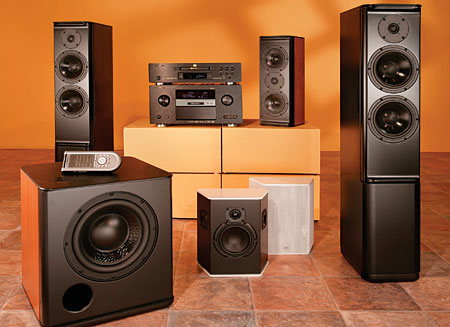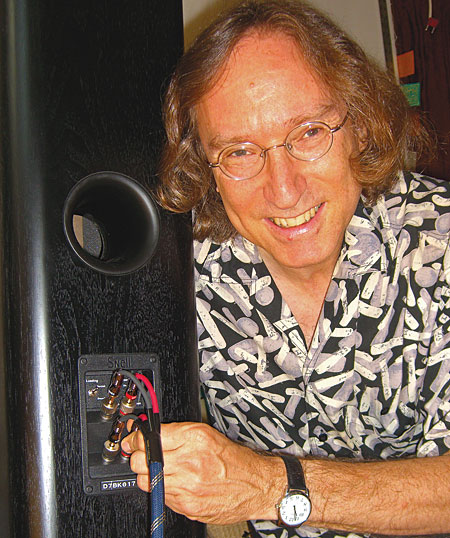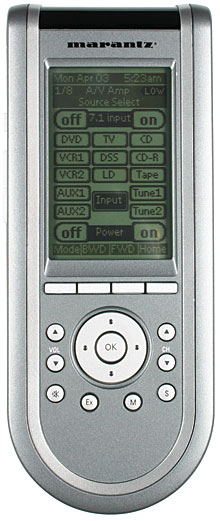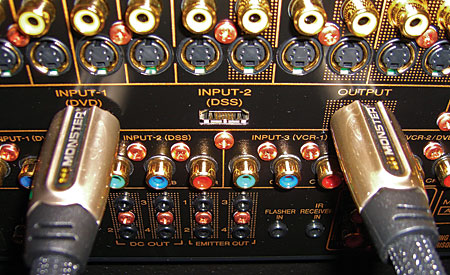Snell D7 Speaker System, Marantz SR9600 A/V Receiver, and Marantz DV9600 Disc Player
As I unboxed this month's Spotlight System, I flashed on the innovative histories of Marantz and Snell Acoustics. Saul B. Marantz was a bona fide American audio pioneer in the 1950s and 1960s. His company's electronics not only sounded amazing, they were drop-dead gorgeous. Maybe that's why Marantz's early designs regularly sell on eBay for more than their original prices. Peter Snell was one of the brightest speaker designers to emerge in the mid-1970s. Back in the day, I owned a pair of his first speakers, the Type A, and had many conversations with Peter about music. In those simpler times, Saul Marantz and Peter Snell could launch their companies armed with not much more than a driving passion to produce great audio gear—and the inspired engineering to make the dream real. Best of all, both companies still adhere to their founders' perfectionistic traditions.

Back to the Future
The SR9600 A/V receiver's classy styling hearkens back to the days when Mr. Marantz was building electronics in the basement of his New York City home. The receiver even sports the brand's signature Gyro-Touch Tuning. (That's the horizontal wheel under the display). Spinning the rubber-rimmed Gyro is more elegant than pushing up/down buttons to tune in the local college radio station. This reminds me that the receiver is available in two versions. The SR9600 comes with two AM/FM tuners, so you can listen to different stations in different rooms of your home. The SR9600XM has a single AM/FM tuner, and, if you add a Connect & Play XM antenna, it can play XM Satellite Radio, as well.
In addition to the SR9600, Marantz sent me the matching DV9600 disc player. Both components feature Marantz's HDAM-SA2 proprietary modular circuit topology, which is said to reduce distortion and produce pure sound. You can find the technology in Marantz's flagship Reference components like the PM-11S1 stereo integrated amplifier and the SA-11S1 stereo SACD/CD player.
I'm happy to report that the HDMI video connection between the SR9600, the DV9600, and my Philips 32PW8422 TV was glitch free. And, since the HDMI connection also delivers Dolby, DTS, CD, and DVD-Audio signals from the player to the receiver, I never even bothered to hook up a coaxial or optical digital cable—or the usual six analog cables between the player and the receiver. And, yes, the joy of single-cable audio/ video hookup will likely apply to a Blu-ray or HD DVD player. I also hooked up the iLink (IEEE 1394 FireWire) connection. Marantz doesn't claim any performance advantage for iLink, but I think it's more transparent sounding than a 5.1-channel analog connection for SACD and DVD-Audio.

The SR9600's touchscreen remote is a two-way design, so, if you can't see the SR9600's display, you can check the input setting, volume, multiroom settings, and more on the touchscreen. If you really want to go all out with programming the remote, hook it up to your PC and check Marantz's Website for software updates. The DV9600's run-of-the-mill, hard-button remote works well enough and doesn't require any special skills. Call me old-fashioned, but it was definitely more my speed.
Inquiring buyers might wonder if the DV9600 disc player ($2,099) is a substantial step up from the Marantz DV7600 ($900). Here's the deal: Compared with its lower-priced sibling, the DV9600 has upgraded video and audio circuits and Version 1.1 HDMI. It also offers FireWire connectivity, and you get 480i, 480p, 720p, 1080i, and 1080p output over the HDMI connection.
Swell Snells
As you might remember, I reviewed the Snell LCR7, the first Series 7 monitor, in the July 2005 issue of Home Theater. The Series 7 line has since expanded with a bunch of new models. All of the freestanding models share the LCR7's gently curved cabinetry and snazzy 0.25-inch-thick aluminum top plates. (The in-wall and in-cabinet Series 7 models obviously do without the styling doodads.) The new D7 tower speaker is more than just a bigger LCR7 with larger woofers. It sports a rear-firing tweeter on its backside. You can switch the rear tweeter on or off, but I almost always left it on because I love the way it added a greater sense of depth to the soundstage. The D7 and LCR7 are biwirable and biampable, features that Peter Snell helped pioneer in the late 1970s. (I used Tributaries Silver cables for biwiring the two speakers.)
 The SR7 looks like a dipole surround speaker, but it's more versatile. A rear-mounted switch toggles to a direct-radiating mode where only the front-mounted 5.25-inch woofer and 1-inch tweeter are engaged; the Diffuse setting adds the side-mounted 2.5-inch midrange drivers and turns off the front tweeter to open up the sound. It's a highly effective surround speaker in either mode.
The SR7 looks like a dipole surround speaker, but it's more versatile. A rear-mounted switch toggles to a direct-radiating mode where only the front-mounted 5.25-inch woofer and 1-inch tweeter are engaged; the Diffuse setting adds the side-mounted 2.5-inch midrange drivers and turns off the front tweeter to open up the sound. It's a highly effective surround speaker in either mode.
The Basis 300 subwoofer sports a 10-inch driver and a 300-watt amp, and it matches the Series 7 styling. The subwoofer crossover control and all of the inputs are on the rear baffle, but the illuminated volume control is handily positioned on the top panel.
The standard available finishes—hand-sanded, hand-oiled real cherry or satin-black walnut veneers—are set off with 0.25-inch-thick machined silver or satin-black aluminum end caps. But, if you want a custom-finished speaker or subwoofer to match your décor, just say the word and send along paint samples. If you'd rather go with Ferrari red or any shade of automotive finish on your speakers, Snell will build a set just for you. Snell can custom paint or plate the speakers' metal caps, as well. They'll even cover the speakers' perforated metal grilles with any color fabric. They won't rule out anything, including building unique speakers based on existing Snell models. The charges for custom finishes vary; many are available for just 15 percent more than standard pricing. Snell is planning on installing a live Webcam shot of the Peabody, Massachusetts, production line on their Website so customers can watch their speakers being built. Is that cool, or what?
The hands-on approach isn't just for the cabinets; it also extends to the way the speakers are built. Snell's factory technicians hand-tune the crossover network to precisely match the drivers in each and every speaker they make. The tweaking process ensures that the Snell speakers' sound matches the corresponding original engineering prototype. In the unlikely event that a customer fries a tweeter or woofer, Snell doesn't just supply a replacement driver; they send a driver and a crossover matched to your original speaker's precise tolerances. The company stocks at least some parts for every speaker they've ever made. That level of long-term customer support is exceedingly rare these days, but, again, it's something that Peter Snell insisted upon.

Plugging In
When I initially set up the Snell/Marantz system, I used another brand's subwoofer and surround speakers from a previous review. I was feeling a little tired and didn't want to lug everything upstairs on the first day, so I hooked up just the D7 towers and LCR7 center speaker to the SR9600. Truth be told, the sound didn't blow me away. While the brand-X sub was no slouch (it's a highly regarded $3,000 model) and the surround speakers were quite good, the sound was disjointed. I took the hint and quickly unboxed and plugged in the Basis 300 subwoofer and the SR7 surround speakers. Ah, yes, that's more like it! The transformation wasn't subtle. The SR7s made for a more completely integrated soundfield, and the front three Snells' imaging snapped into tighter focus. The Basis 300's bass kicked the system into high gear, and overall dynamics were much improved.
The D7 towers sounded best when run small, with the SR9600's bass management directing bass under 80 hertz to the Basis 300 sub. I had started out with the SR9600's bass-management crossover lower, at 60 Hz, but the D7s' bass was too lean. To put it another way, I just prefer the richer, warmer tonal balance that the 80-Hz crossover provides. That's the nice thing about this Snell/Marantz system: It's easy to tune the sound to your liking. And, if you'd rather not bother with all that techie stuff, sit back and let the SR9600's M.R.A.C. (Marantz Room Acoustic Calibration) auto-setup system do the number crunching for you.
 Start Me Up
Start Me Up
Starting with the Rolling Stones' Four Flicks DVD boxed set, I knew I was in for a good time. The box contains three complete concerts from the Stones' 2002–'03 world tour, but I stuck with my hometown show in New York City's Madison Square Garden. The sense of being there, feeling the band and the crowd's energy, pumped me up. Mick Jagger's vocals were in great shape, and his stage antics kept my eyes entertained. But, as I sat there taking it all in, I couldn't help but feel that the Stones are really Keith Richards' band. As I watched him strut about the stage, I had no doubt that he was running the show, and his opening stabbing guitar licks on "Honky Tonk Women" sent shivers up my spine.
Stay, a moody psycho thriller starring Ewan McGregor as a dedicated shrink and Ryan Gosling as his suicidal patient, put me into nail-biting mode. The DV9600 matched the film's dazzling visuals with a surround mix that provided a wraparound curtain of muttering voices, guttural breathing, throbbing beats, and a menagerie of unsettling sounds. The system reproduced the end-over-end car crash on the Brooklyn Bridge with frightening physicality and clarity. The Basis 300's bass delivered the whiplash impact I often associate with larger subs without forfeiting the tuneful definition I crave.
I was feeling bruised and battered, so I settled into the soothing sounds of Neil Young's Prairie Wind DVD. The high-resolution 96/24 stereo mix had such a remarkably three-dimensional quality, I had to check the disc to make sure I wasn't listening in surround. Nope, it's just stereo, but it was as 3-D as stereo ever gets. Plain-vanilla CDs, like the jump-jazz soundtrack to Robert Altman's Kansas City, were spectacularly vivid. Talk about high energy. The re-creation of the 1930s-era improvised cutting contests—where jazz musicians would try to out-swing each other—took on a life of their own. Lesser components and speakers can make this music sound harsh, but it was a total joy here.
The highly charged intimacy of Steve Earle's solo acoustic performance on his Live at Montreux 2005 DVD took my breath away. The Snell/Marantz system flat-out disappeared as a presence in my home theater. I felt Earle's passion as if the man and his guitar were right there in front of me. This effect was, after all, exactly what Saul Marantz and Peter Snell were striving for. I bet they'd love the sound of this system, and I think you will, too.
Highlights
Snell D7 Speaker System:
• Built in the United States
• Snell offers a vast range of custom finish options
Highlights
Marantz SR9600 A/V Receiver and DV9600 Disc Player:
• Marantz's best-ever A/V receiver
• DVD/SACD/CD player with HDMI output up to 1080p
- Log in or register to post comments




































































